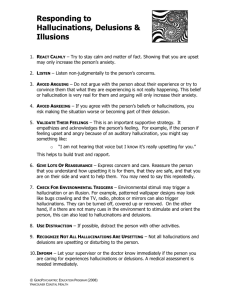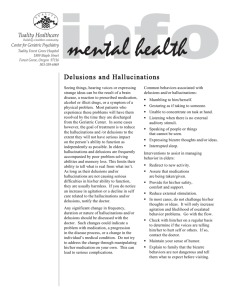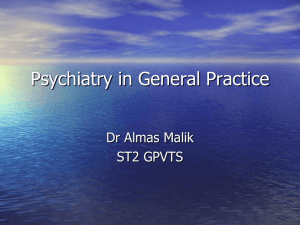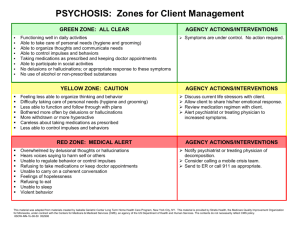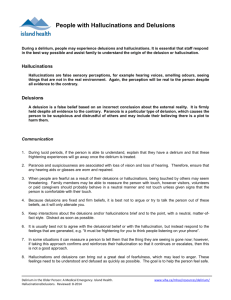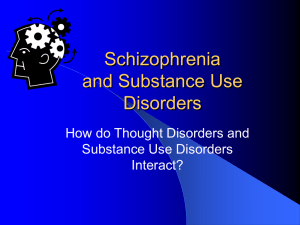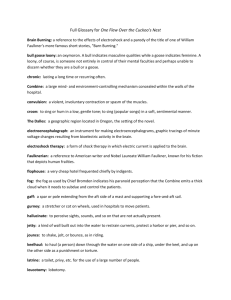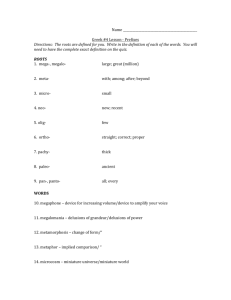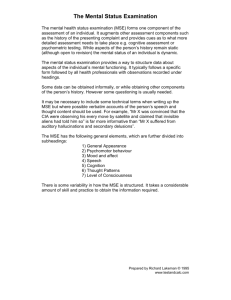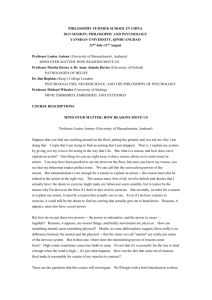Hallucinations and Delusions: How to Respond
advertisement
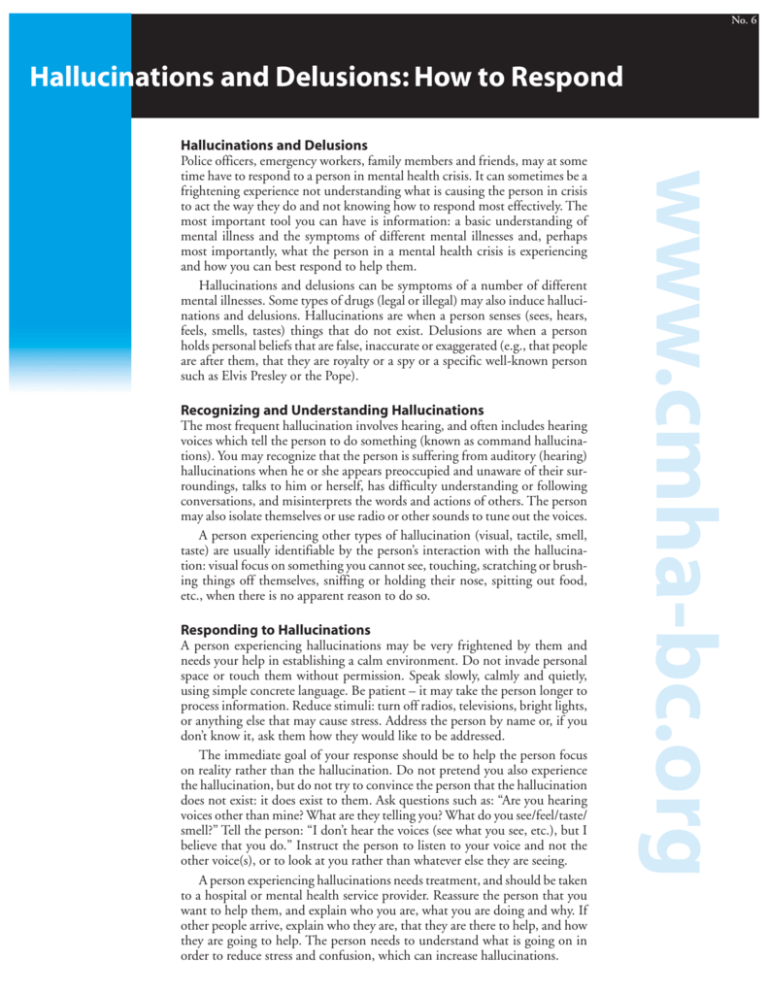
No. 6 Hallucinations and Delusions: How to Respond Recognizing and Understanding Hallucinations The most frequent hallucination involves hearing, and often includes hearing voices which tell the person to do something (known as command hallucinations). You may recognize that the person is suffering from auditory (hearing) hallucinations when he or she appears preoccupied and unaware of their surroundings, talks to him or herself, has difficulty understanding or following conversations, and misinterprets the words and actions of others. The person may also isolate themselves or use radio or other sounds to tune out the voices. A person experiencing other types of hallucination (visual, tactile, smell, taste) are usually identifiable by the person’s interaction with the hallucination: visual focus on something you cannot see, touching, scratching or brushing things off themselves, sniffing or holding their nose, spitting out food, etc., when there is no apparent reason to do so. Responding to Hallucinations A person experiencing hallucinations may be very frightened by them and needs your help in establishing a calm environment. Do not invade personal space or touch them without permission. Speak slowly, calmly and quietly, using simple concrete language. Be patient – it may take the person longer to process information. Reduce stimuli: turn off radios, televisions, bright lights, or anything else that may cause stress. Address the person by name or, if you don’t know it, ask them how they would like to be addressed. The immediate goal of your response should be to help the person focus on reality rather than the hallucination. Do not pretend you also experience the hallucination, but do not try to convince the person that the hallucination does not exist: it does exist to them. Ask questions such as: “Are you hearing voices other than mine? What are they telling you? What do you see/feel/taste/ smell?” Tell the person: “I don’t hear the voices (see what you see, etc.), but I believe that you do.” Instruct the person to listen to your voice and not the other voice(s), or to look at you rather than whatever else they are seeing. A person experiencing hallucinations needs treatment, and should be taken to a hospital or mental health service provider. Reassure the person that you want to help them, and explain who you are, what you are doing and why. If other people arrive, explain who they are, that they are there to help, and how they are going to help. The person needs to understand what is going on in order to reduce stress and confusion, which can increase hallucinations. www.cmha-bc.org Hallucinations and Delusions Police officers, emergency workers, family members and friends, may at some time have to respond to a person in mental health crisis. It can sometimes be a frightening experience not understanding what is causing the person in crisis to act the way they do and not knowing how to respond most effectively. The most important tool you can have is information: a basic understanding of mental illness and the symptoms of different mental illnesses and, perhaps most importantly, what the person in a mental health crisis is experiencing and how you can best respond to help them. Hallucinations and delusions can be symptoms of a number of different mental illnesses. Some types of drugs (legal or illegal) may also induce hallucinations and delusions. Hallucinations are when a person senses (sees, hears, feels, smells, tastes) things that do not exist. Delusions are when a person holds personal beliefs that are false, inaccurate or exaggerated (e.g., that people are after them, that they are royalty or a spy or a specific well-known person such as Elvis Presley or the Pope). Recognizing and Understanding Delusions Some delusions may seem relatively harmless in the short term, such as delusions of being a rock star, royalty, or a religious figure. These delusions can be potentially harmful, however, if they include or lead to delusions of having special abilities or characteristics such as flying, walking on water, or invincibility. Most common, however, are paranoid delusions: the belief that someone or something is going to harm the person in some way. Paranoid delusions are usually evidenced by extreme suspicion, fear, isolation, insomnia (for fear of being harmed while asleep), avoidance of food and/ or medication (for fear of poisoning), and sometimes violent actions. A person experiencing paranoid delusions has extreme difficulty trusting others, will frequently misinterpret others’ words and actions, and experience ordinary things in his or her environment as a threat. Building Capacity: Mental Health and Police Project (BC:MHAPP) is a project of the Canadian Mental Health Association’s BC Division, with a goal of improving interactions between police, emergency services, and people with mental illness. This fact sheet is produced as part of the BC:MHAP Project. These fact sheets have been supported by gaming revenue from the Province of British Columbia. This project is supported by the Vancouver Foundation and the Provincial Health Services Authority. This fact sheet is one in a series of eight: • Police and Mental Illness: Increased Interactions • Criminalization of Mental Illness • Violence and Mental Illness: Unpacking the Myths • Police and Mental Illness: Models that Work • Mental Health Crises: Frequently Asked Questions • Hallucinations and Delusions: How to Respond • Mental Illness and Substance Use Disorders: Key Issues • Suicidal Behaviour: How to Respond Responding to Delusions Until you know the content and context of the delusion, it is important to keep yourself safe from potentially violent reactions, and provide a comfort zone for the person experiencing delusions. Keep a safe distance or some barrier (such as a piece of furniture) between the two of you. Do not touch the person without permission. Position yourself at the person’s level if it is safe to do so. Do not whisper or laugh, as this may be misunderstood and may increase paranoia. Remember that someone experiencing delusions may not always be honest about what they think or believe; especially if their delusions are paranoid, the person may not trust you enough to be honest. Ask questions about what the delusion is all about, particularly any elements which indicate the potential for harming self or others (e.g. “Are you having any thoughts about hurting yourself or others?”) Do not attack delusions or try to argue or convince the person that the thoughts are wrong or not real. Nor should you indicate that you believe in the delusion; instead explain “I believe you are telling me this is as you see it.” Do not smile or shake your head when the person speaks – this may lead to misunderstanding. Ask whether there is anything you can do to make the person feel more comfortable, and explain your intentions before you act. Police officers and other persons in uniform must realize the potentially intimidating impact of the uniform on someone suffering from paranoid delusions. It is important to assure the person that they are safe, that you are not going to harm them, that the uniform and equipment you carry are for protecting them and that is what you want to do – protect them. Earning trust in order to help the person get treatment is the goal, while at the same time maintaining safety for all. Hallucinations and delusions can be frightening for both the person experiencing them and for those who come in contact with that person, including police officers. Maintaining safety for everyone, and providing a calm, clear and persistent message that you want to help the person in need, while at the same time giving that person the time and space to hear and respond to that message, is the best response you can give as first responder. For more information on this project, please contact Camia Weaver, Provincial Co-ordinator for BC:MHAPP, CMHA BC Division, at info@cmha-bc.org or 604-688-3234. Published March 2005 BC DIVISION
